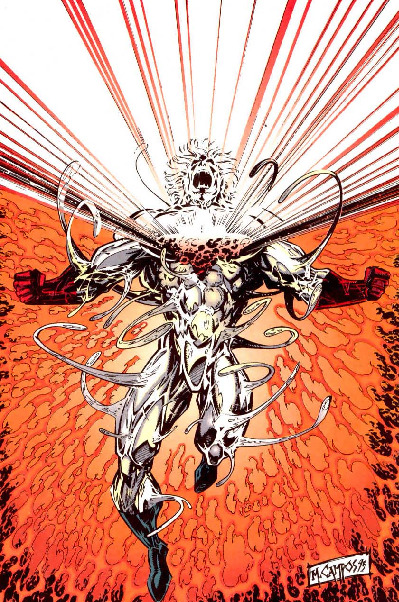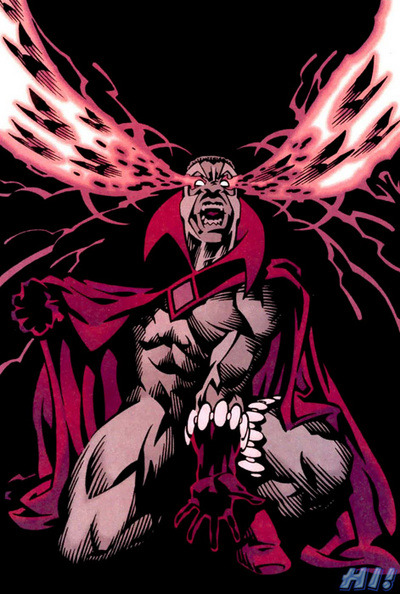From 1992.
| via Comic Book Resources |
"...But not an evidence trail. A trail of references, and hunches. Game-shows, lizard-headed devils. Comic books..."I'd love for something like this to be reprinted, and for Martian Manhunter himself, for all intents and purposes, to be rediscovered. If Ed Brubaker ever came back to DC, this is exactly the character he should write. The same goes for Jason Aaron. Heck, bring them both back and we can have a whole Martian Manhunter renaissance...
Martian Manhunter Special (DC)
From 1996.
| via DC Wikia |
 |
| via Tumblr |
 |
| via Tumblr |
Martian Manhunter #1,000,000 (DC)
From 1998.
| via DC Wikia |
Miss Peregrine's Home for Peculiar Children: The Graphic Novel Halloween ComicFest Preview (Yen Press)
From 2013.
Adapted from the acclaimed novel by Ransom Riggs, which I haven't read, for a graphic novel released early this year, which I also have not read, this becomes my first real exposure to the 2011 book, which will be a movie in 2016 starring the increasingly ubiquitous Eva Green (who has also starred in comics-related 300: Rise of an Empire and Sin City: A Dame to Kill For). If this had originated as a Vertigo project, it would have fit in comfortably with Sandman and The Unwritten, a tale of a boy trying to reconcile the stories he used to hear from his grandfather which seemed too fantastic to be real, but as it turns out they were. The Halloween ComicFest freebies are the unheralded cousins to Free Comic Book Day. There are mini-comics (geared exclusively to kids) and also full-size releases like this one.
The Spectacular Spider-Man #229 (Marvel)
From 1995.
My earliest superheroes favorites were Robin and Spider-Man (two sides of the same coin, really). These were the days when I knew superheroes exclusively from their TV appearances, which meant I knew Burt Ward's Robin and Spider-Man and His Amazing Friends. By the time I started reading comics in the '90s, Tim Drake had become the third Robin, and...well, the Clone Saga was happening. Every major superhero had some kind of crisis during that decade. Superman was killed, Batman was broken, Green Lantern went insane, Wonder Woman was replaced. And Spider-Man underwent the most extreme existential crisis ever: Peter Parker met Ben Reilly, and for a time neither knew which one was the clone. It was a sprawling story that infuriated fans more than anything, mostly because it seemed the writers were, well, webslinging it as they went along. I always felt it was maybe not deserving of all the hate it received, but then, I also didn't read any of it. I was a DC guy by that point, had very little time for Marvel. I think in hindsight, the Clone Saga is a perfect embodiment of what Marvel was for decades, a company that told the kinds of one-and-done stories DC became known for in the Silver Age, filled with sensational misdirection as a matter of course (if you heard the term "life model decoy" when people were trying to figure out how Agent Coulson was alive at the start of Agents of S.H.I.E.L.D. despite his death in the preceding Avengers, you have a sense of what I'm talking about), the very idea of instant retcon with every new creative team. This issue is Peter Parker walking away from the whole mess (for a while), allowing Ben Reilly to assume the webbing as he tries to make sense of his ordinary life (again). In case you were wondering, Ben Reilly was definitely the clone. It's a whole era fans are still trying to remember positively, meaning its legacy in Spider-Man's history is still nowhere close to "Knightfall" or "Doomsday" despite the fact that Marvel itself keeps building off of it (to say nothing of the Ultimate Spider-Man version!).
Geoff Johns famously wrote into the letters column of Superboy, before he broke into comics, and offered his suggestion of the human DNA used to create Kon-El as having come from Lex Luthor. This was something he made reality a relative handful of years later in the pages of Teen Titans. Yet the best and subsequently undervalued work was done in the pages of Adventure Comics in what was also Johns' first collaboration with eventual Flash artist Francis Manapul, which led to the second Superboy ongoing series, written by Jeff Lemire. After the New 52 reboot literally rebooted the character, this was a whole era that was consigned to the history books when it ought to have ushered a renaissance of appreciation. This issue features a chilling version of Luthor, willing to do awful things to his own niece (another lost element, alas), one that trades heavily on his if-only-Superman-weren't-here self-mythology, and contrasts nicely with Johns' own Forever Evil version. For fans like me, T-Shirt Superboy will always come in second place to Don't Call Me Superboy despite what Johns brought to the character, but this is an exception that deserves greater recognition. Johns cleverly punctuated the arc with Superboy's running "What did Superman/does Lex Luthor do?" in the narration boxes, which I found instantly iconic, more relevant than what had been done with the character, outside of Johns and Karl Kesel, for years.
| via Halloween ComicFest |
The Spectacular Spider-Man #229 (Marvel)
From 1995.
| via SpiderFan |
Adventure Comics #6/509 (DC)
From 2010.
| via Newkadia |
No comments:
Post a Comment
Note: Only a member of this blog may post a comment.